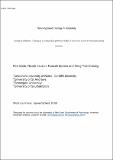Files in this item
Acting in solidarity: testing an extended dual-pathway model of collective action by bystander group members
Item metadata
| dc.contributor.author | Saab, Rim | |
| dc.contributor.author | Tausch, Nicole | |
| dc.contributor.author | Spears, Russell | |
| dc.contributor.author | Cheung, Wing | |
| dc.date.accessioned | 2017-09-01T23:31:50Z | |
| dc.date.available | 2017-09-01T23:31:50Z | |
| dc.date.issued | 2015-09 | |
| dc.identifier | 150587047 | |
| dc.identifier | 99c1b041-31e7-4612-86f5-a220d1e3706e | |
| dc.identifier | 84941026638 | |
| dc.identifier | 000361218000008 | |
| dc.identifier.citation | Saab , R , Tausch , N , Spears , R & Cheung , W 2015 , ' Acting in solidarity: testing an extended dual-pathway model of collective action by bystander group members ' , British Journal of Social Psychology , vol. 54 , no. 3 , pp. 539-560 . https://doi.org/10.1111/bjso.12095 | en |
| dc.identifier.issn | 0144-6665 | |
| dc.identifier.other | ORCID: /0000-0002-9471-0673/work/46362111 | |
| dc.identifier.uri | https://hdl.handle.net/10023/11595 | |
| dc.description.abstract | We examined predictors of collective action among bystander group members in solidarity with a disadvantaged group by extending the dual pathway model of collective action, which proposes one efficacy-based and one emotion-based path to collective action (van Zomeren, Spears, Fischer, & Leach, 2004). Based on two proposed functions of social identity performance (Klein, Spears, & Reicher, 2007), we distinguished between the efficacy of collective action at consolidating the identity of a protest movement and its efficacy at achieving social change (political efficacy). We expected identity consolidation efficacy to positively predict collective action tendencies directly and indirectly via political efficacy. We also expected collective action tendencies to be positively predicted by moral outrage and by sympathy in response to disadvantaged outgroup’s suffering. These hypotheses were supported in two surveys examining intentions to protest for Palestine in Britain (Study 1), and intentions to attend the June 4th vigil in Hong Kong to commemorate the Tiananmen massacre among a sample of Hong Kong citizens (Study 2). The contributions of these findings to research on the dual pathway model of collective action and the different functions of collective action are discussed. | |
| dc.format.extent | 502994 | |
| dc.language.iso | eng | |
| dc.relation.ispartof | British Journal of Social Psychology | en |
| dc.subject | Efficacy | en |
| dc.subject | Collective action | en |
| dc.subject | Identity consolidation | en |
| dc.subject | Solidarity | en |
| dc.subject | Bystander group | en |
| dc.subject | BF Psychology | en |
| dc.subject | NDAS | en |
| dc.subject.lcc | BF | en |
| dc.title | Acting in solidarity: testing an extended dual-pathway model of collective action by bystander group members | en |
| dc.type | Journal article | en |
| dc.contributor.institution | University of St Andrews. School of Psychology and Neuroscience | en |
| dc.identifier.doi | 10.1111/bjso.12095 | |
| dc.description.status | Peer reviewed | en |
| dc.date.embargoedUntil | 2017-09-01 |
This item appears in the following Collection(s)
Items in the St Andrews Research Repository are protected by copyright, with all rights reserved, unless otherwise indicated.

